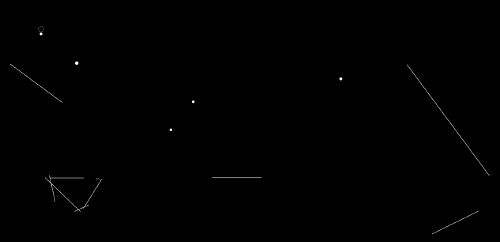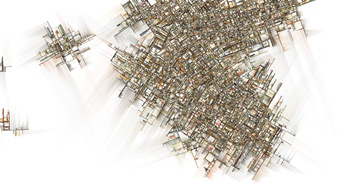GMU:Einführung ins Programmieren mit Processing/Seminar: Difference between revisions
WSebastian (talk | contribs) mNo edit summary |
(added Substrate by J. Tarbell) |
||
| Line 41: | Line 41: | ||
Dan S. Designing for interaction. ''The four approaches to interaction design''. (2001) <br/> | Dan S. Designing for interaction. ''The four approaches to interaction design''. (2001) <br/> | ||
[http://www.michelepasin.org/techblog/2010/02/18/processing-js-iprocessing-javascript-does-everything-for-you/ Processing.js, iProcessing: javascript does everything for you! ] | [http://www.michelepasin.org/techblog/2010/02/18/processing-js-iprocessing-javascript-does-everything-for-you/ Processing.js, iProcessing: javascript does everything for you! ] | ||
| Line 48: | Line 49: | ||
<br clear="all"> | <br clear="all"> | ||
=== | |||
====Substrate==== | |||
by Jared Tarbell [http://www.complexification.net/gallery/machines/substrate/index.php] | |||
http://www.complexification.net/gallery/machines/substrate/substrate0001s.jpg<br/> | |||
''0001 iterated substrate'' by Jared Tarbell [http://www.complexification.net/gallery/machines/substrate/substrate0001.jpg] | |||
'''Substrate''' is a piece of generative art written in processing that creates a landscape looking a lot like urban plans. | |||
At the start of the program a couple of straight black lines are placed randomly on the canvas. They expand during the program, each line growing other lines at right angle but at random positions and at random times. This process is repeated for the newly grown lines. The expansion of a line stops when it collides with another line. | |||
Each line has a shadowish colouring of variable hue and amplitude to the left of the line's growing direction. | |||
Due to the different angles of the starting lines the growing image consists of distinguishable parts that could resemble city districts if the image was compared to an urban plan. | |||
'''Substrate''' seems particularly interesting as it creates beautiful patterns using a rather simple algorithm. | |||
(md) | |||
Revision as of 20:01, 28 October 2011
28/10
Homework
Check the links below. Choose one or two projects, works you really like and write a short text about it. (why you like it, what is interesting for you and what happens there. Feel free to look at other sources as well. We'll have a look at them tomorrow.
http://processing.org/exhibition/
http://www.openprocessing.org/
http://vimeo.com/groups/processing
http://www.visualcomplexity.com/vc/
http://www.creativeapplications.net
http://www.complexification.net
Patawat Phamuad
project:
Balldroppings

click at above picture to go to application.
description:
This web-based application is constructed from Processing.js, a part of Processing language which is able to run on browser. The most interesting point of this project is to focus on both 2 of 4 approaches to interactive design.
For the first approach "User-Centered Design" , the designer tried to make a simple drum without any complicated set of drum pieces. Only lines and circles working with physic law are able to initiate a set of user-based instrument. Importantly, the user foresees what is supposed to be happened without any instructions.
Furthermore, the second approach focuses on "Activity-Center Design" . The system flows until the user press "close" button on web browser. The system has no fixed ending. Thus, the designer designed tool for actions. In addition, each action directly depends on each own person's experience and mental processes. (Exteriorized:-interesting in what people do)
system & technology:
I.application processes active to each order <balls & lines>
II.Users active to application process. <dragging line & outputsound>
III. Processing.js + html5
referred:
Dan S. Designing for interaction. The four approaches to interaction design. (2001)
Processing.js, iProcessing: javascript does everything for you!
Sebastian
<videoflash type=vimeo>27158491|549|309</videoflash>
Substrate
by Jared Tarbell [1]

0001 iterated substrate by Jared Tarbell [2]
Substrate is a piece of generative art written in processing that creates a landscape looking a lot like urban plans.
At the start of the program a couple of straight black lines are placed randomly on the canvas. They expand during the program, each line growing other lines at right angle but at random positions and at random times. This process is repeated for the newly grown lines. The expansion of a line stops when it collides with another line.
Each line has a shadowish colouring of variable hue and amplitude to the left of the line's growing direction.
Due to the different angles of the starting lines the growing image consists of distinguishable parts that could resemble city districts if the image was compared to an urban plan.
Substrate seems particularly interesting as it creates beautiful patterns using a rather simple algorithm.
(md)